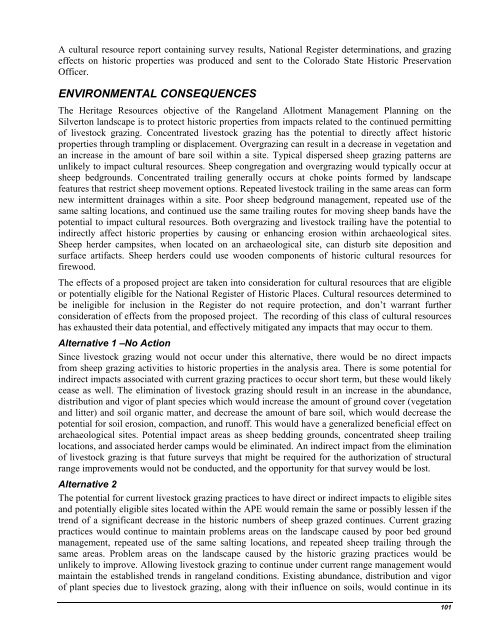NEPA--Environmental Assessment
NEPA--Environmental Assessment
NEPA--Environmental Assessment
You also want an ePaper? Increase the reach of your titles
YUMPU automatically turns print PDFs into web optimized ePapers that Google loves.
A cultural resource report containing survey results, National Register determinations, and grazing<br />
effects on historic properties was produced and sent to the Colorado State Historic Preservation<br />
Officer.<br />
ENVIRONMENTAL CONSEQUENCES<br />
The Heritage Resources objective of the Rangeland Allotment Management Planning on the<br />
Silverton landscape is to protect historic properties from impacts related to the continued permitting<br />
of livestock grazing. Concentrated livestock grazing has the potential to directly affect historic<br />
properties through trampling or displacement. Overgrazing can result in a decrease in vegetation and<br />
an increase in the amount of bare soil within a site. Typical dispersed sheep grazing patterns are<br />
unlikely to impact cultural resources. Sheep congregation and overgrazing would typically occur at<br />
sheep bedgrounds. Concentrated trailing generally occurs at choke points formed by landscape<br />
features that restrict sheep movement options. Repeated livestock trailing in the same areas can form<br />
new intermittent drainages within a site. Poor sheep bedground management, repeated use of the<br />
same salting locations, and continued use the same trailing routes for moving sheep bands have the<br />
potential to impact cultural resources. Both overgrazing and livestock trailing have the potential to<br />
indirectly affect historic properties by causing or enhancing erosion within archaeological sites.<br />
Sheep herder campsites, when located on an archaeological site, can disturb site deposition and<br />
surface artifacts. Sheep herders could use wooden components of historic cultural resources for<br />
firewood.<br />
The effects of a proposed project are taken into consideration for cultural resources that are eligible<br />
or potentially eligible for the National Register of Historic Places. Cultural resources determined to<br />
be ineligible for inclusion in the Register do not require protection, and don’t warrant further<br />
consideration of effects from the proposed project. The recording of this class of cultural resources<br />
has exhausted their data potential, and effectively mitigated any impacts that may occur to them.<br />
Alternative 1 –No Action<br />
Since livestock grazing would not occur under this alternative, there would be no direct impacts<br />
from sheep grazing activities to historic properties in the analysis area. There is some potential for<br />
indirect impacts associated with current grazing practices to occur short term, but these would likely<br />
cease as well. The elimination of livestock grazing should result in an increase in the abundance,<br />
distribution and vigor of plant species which would increase the amount of ground cover (vegetation<br />
and litter) and soil organic matter, and decrease the amount of bare soil, which would decrease the<br />
potential for soil erosion, compaction, and runoff. This would have a generalized beneficial effect on<br />
archaeological sites. Potential impact areas as sheep bedding grounds, concentrated sheep trailing<br />
locations, and associated herder camps would be eliminated. An indirect impact from the elimination<br />
of livestock grazing is that future surveys that might be required for the authorization of structural<br />
range improvements would not be conducted, and the opportunity for that survey would be lost.<br />
Alternative 2<br />
The potential for current livestock grazing practices to have direct or indirect impacts to eligible sites<br />
and potentially eligible sites located within the APE would remain the same or possibly lessen if the<br />
trend of a significant decrease in the historic numbers of sheep grazed continues. Current grazing<br />
practices would continue to maintain problems areas on the landscape caused by poor bed ground<br />
management, repeated use of the same salting locations, and repeated sheep trailing through the<br />
same areas. Problem areas on the landscape caused by the historic grazing practices would be<br />
unlikely to improve. Allowing livestock grazing to continue under current range management would<br />
maintain the established trends in rangeland conditions. Existing abundance, distribution and vigor<br />
of plant species due to livestock grazing, along with their influence on soils, would continue in its<br />
101

















